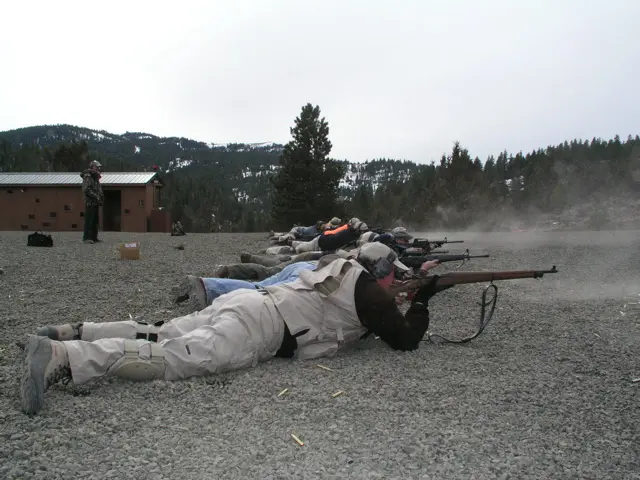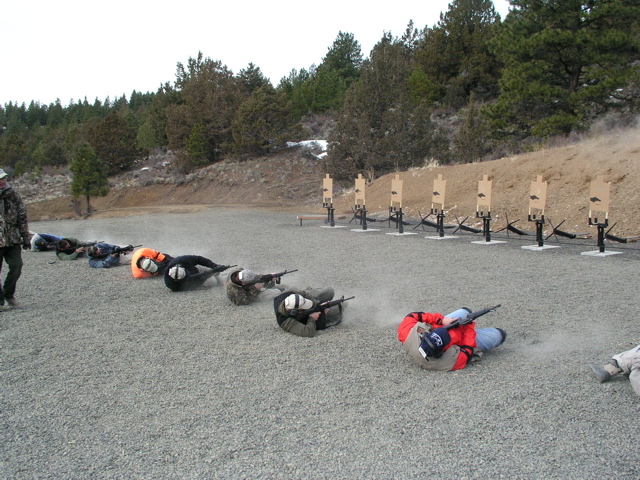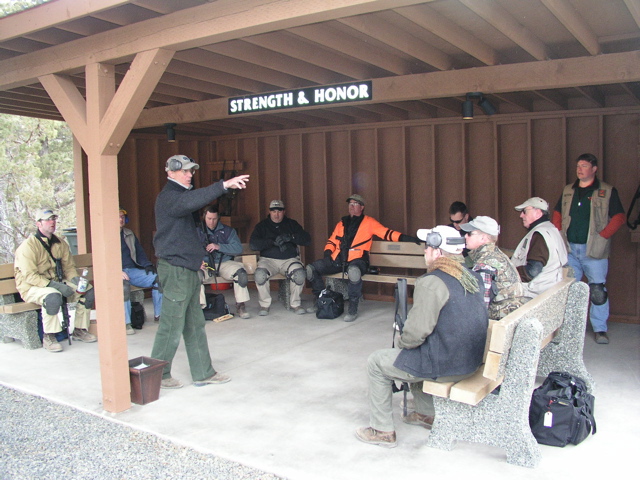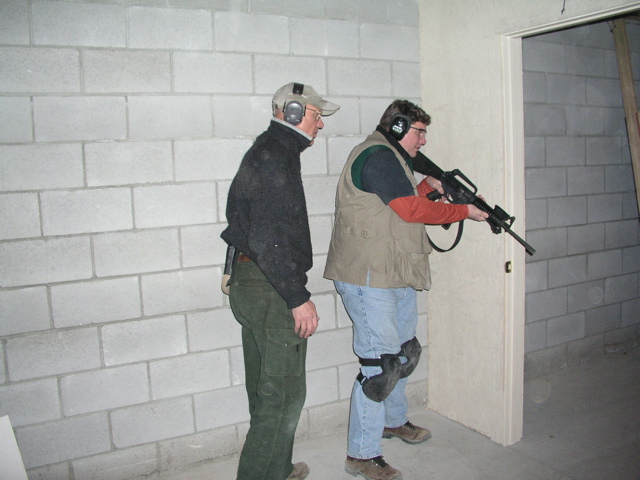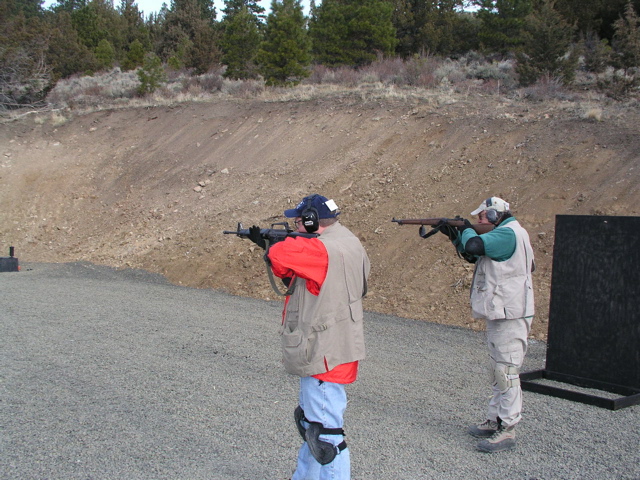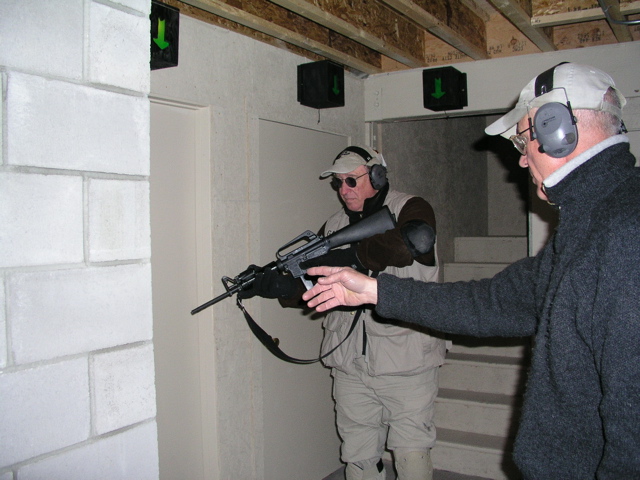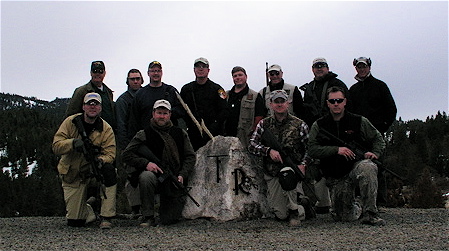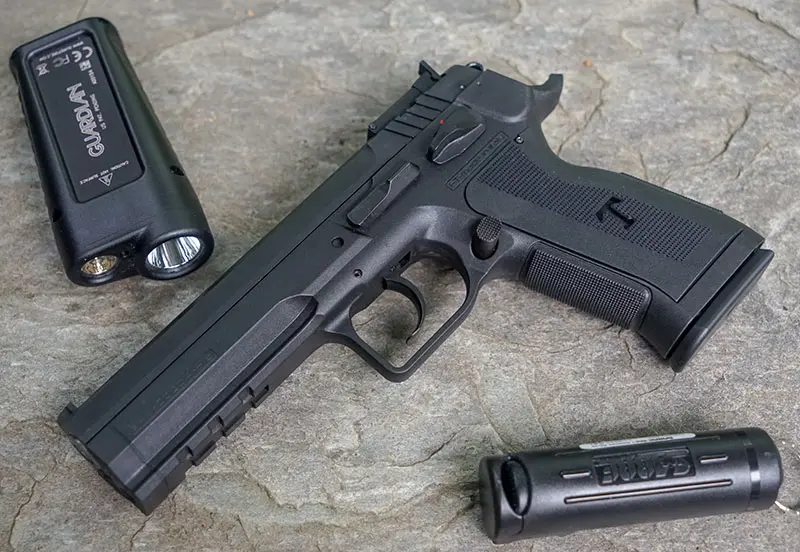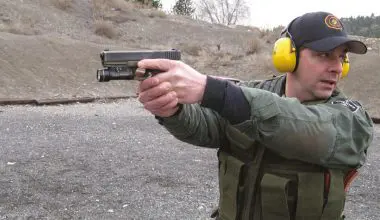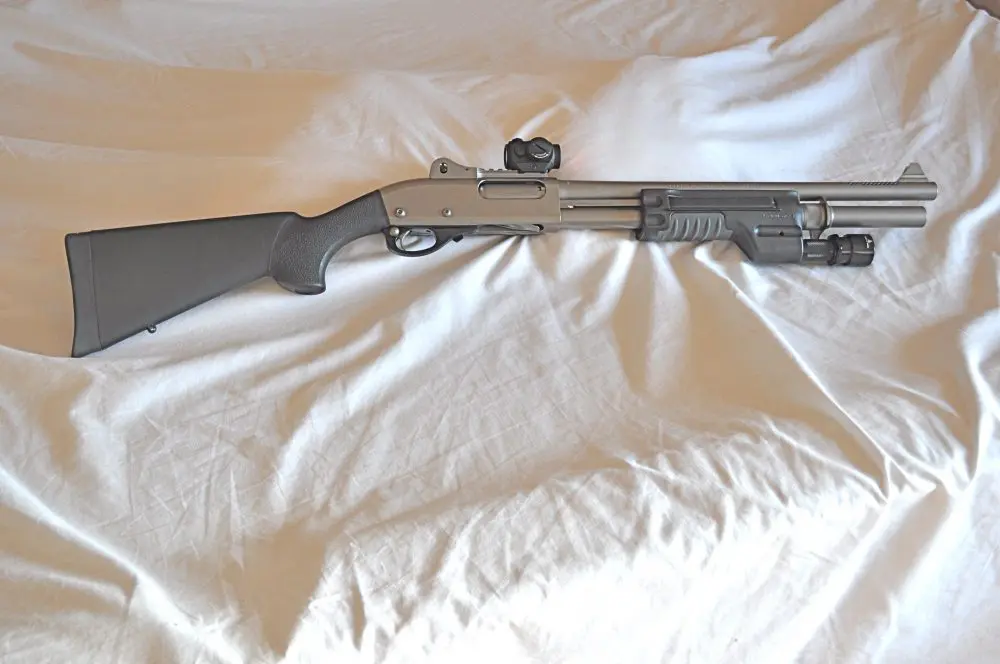I guess I am the most fortunate shooter in these here parts. I recently had the distinct pleasure, along with my son-in-law Zan, of being in the last class at Thunder Ranch, Texas—and in the first class at Thunder Ranch, Oregon.
Being in both classes has given me an opportunity to compare the two schools, both in their structure and mental attitude. The Oregon school is the culmination of a thirty-year journey for its director and founder, Clint Smith and his lovely and accomplished wife, Heidi.
First Urban Rifle class. Watch those wobblers!
Clint’s history in the firearms field is well known. He is a Marine Corps, two-tour veteran of the Vietnam conflict during which he served in both the Infantry and Combined Action Platoons. In law enforcement, he served as head of his Firearms Training Division, as well as being a SWAT member and Precision Rifleman. After leaving law enforcement, he was Dean of Instruction for the American Pistol Institute (later named Gunsite Academy) and was instrumental in the development of its range and curriculum.
In 1983, Clint founded International Training Consultants (ITC)—a mobile training program teaching in both long-gun and handgun formats.
In 1986, Clint was Director of Training for Heckler and Koch, Inc. where he developed and taught classes in automatic and conventional weapons systems.
During his years of teaching he formulated plans for his own school, which was to improve on defensive firearms training then available to the public. That school was aptly named Thunder Ranch, which opened in 1993 near Mountain Home, Texas. Eleven years later, the “Ranch” had taught five hundred classes to about 12,000 students.
Students learn to fight with rifles from the ground, on their backs.
As many S.W.A.T. readers know, Thunder Ranch, Texas was located on a 3,400 acre parcel of land located an hour and a half from San Antonio. The facility contained five ranges, each aptly named White, Yellow, Orange, Red, and Black. They were situated over about a half-mile distance, and faced the same direction for purposes of downrange impact. The ranges were primarily square in shape, up to 300 yards in length, and accommodated up to twenty-four shooters. Some were used for traditional teaching of long guns (rifle and shotgun) and handguns, but others had very novel and useful teaching equipment. Examples of these were targets that were not static and required the student to recognize that targets don’t stand still waiting to be shot. Another set of targets was called “Runners” which traversed back and forth at various speeds and could be hidden behind a barricade. The most intensive course was the “Chargers” where two targets actually moved rapidly toward the student.
Additionally, Clint built a structure called the Terminator that was used for building-clearing exercises. The Terminator had changeable interior walls so different floor plans could be set up for students to solve. The Tower, a multi-story building used for rifle training, was designed to require students to use every shooting position from prone to standing.
The Ranch also had a little “village” called Thunderville, which the students traversed and shot at pop-up targets housed in a simulated group of store fronts about twenty-five yards away. There was also a Western-style course of fire used for Cowboy Action scenarios.
The author with his “03A3.” No .223 here!
Besides the ranges, the facility included an administration building that also housed the “pro shop” (one of my favorite places) and the school’s offices. There also was a separate building used for range maintenance and equipment.
The last class, Class 470, “Old Rifle”, was held in November, 2004. My son-in-law Zan and I were fortunate to be in this class along with twenty-two other students. I use the term “student” very loosely, because a few of them were former and present Thunder Ranch instructors who wanted and deserved to be present at this memorable class. In fact, one student had attended more than forty classes, including all the presentations of Old Rifle. The instructors chosen to lead this class were a top-notch bunch. In addition to Clint, we had Ray Coffman, Scott Anderson, Jack and Rick Furr, Jim Welch, and Bill “Gunga Din” Black. More on him later on.
The Old Rifle Class was developed to illustrate that military rifles designed before 1950 could certainly be relied upon to keep pace with anything the Ranch had to dish out. One exercise in particular was quite impressive. We were out on the top of the Black Range 300-yard berm shooting at the steel targets in the distance. Up to 300 yards everyone hit, including those with the M1 Carbines. When we got out to 400, 500, and 600 the Garands, Enfields, and Springfield ‘03s continued to show their mettle. However, when we went further out the smokeless rifles dropped off and the only ones hitting were those with black powder cartridge rifles designed 125 years ago. Now that was something to see!
Clint makes a point at the Range Hut.
The night before the last day of class, we had the traditional Thursday night dinner. However, this night was very special and one that brought a glistening eye to most who were there. Clint had invited many present and former instructors to attend, as well as many of his friends from the local area. Bill Black donned his 19th Century English helmet and recited Rudyard Kipling’s poem of the water bearer Gunga Din. I don’t think I shall ever forget Bill’s accent and the words “Din, Din, Din”. Finally, Clint made a rather dramatic presentation to seven individuals. He presented each person with a U.S. flag which had flown at the front gate of Thunder Ranch. Obviously, these were seven important people to Clint and Heidi.
The next day was both sad and pleasant. After the final class and the “Last Shot Ceremony” at the Black Range, we watched Clint and the staff take down the Thunder Ranch sign at the school entrance. An era was passing, but we all knew it was for the better. A new life was beginning in Oregon.
In early February, Zan and I got off the plane in Sacramento and picked up a rental car to drive to Lakeview. We had reserved a two-day tutorial with Clint for Monday and Tuesday. This is a departure from the Texas class format. Only three-day classes are held—Wednesday through Friday. Clint conducts only private tutoring on the prior days.
Clint gives instructions to Zan, in the new Terminator.
Clint’s first class was his signature course, Urban Rifle. However, Zan and I are avid shooters at our local club in suburban Atlanta—the River Bend Gun Club—which puts on an annual John C. Garand match. Therefore, we brought our Springfield Models 1903 and ’03 A3 so we could concentrate on proper technique. We also brought revolvers to get hands-on training in defensive techniques.
Spending two solid days with Clint is a real treat. We learned more in those two days than I thought possible. What’s more, because we were the only students he was able to give more of himself than if we were in a large class. In fact, it was the little things that he imparted that stick in my mind—how to loop up, trigger control, shooting smoothly, tips on pocket carry, etc.
This is one of the many differences between the Texas and Oregon schools. Clint is the teacher here. In Texas he was less involved and more of an administrator. That does not mean that the classes were not well taught; they certainly were because Clint was involved with the instructors whom he selected.
Two lefties with rifles far apart in age!
Every capable shooting school begins with its range and related facilities. The new range facility is designed as an efficient group of related modules. First, the administrative center is comprised of one building with internally related uses. At one end is the classroom building. This room is designed for ten students, whereas the Texas school was designed to handle classes with twenty or more students. This has added benefits which I’ll go into later in this article. The classroom converts into the dining room at lunchtime and, of course, becomes the room for the class graduation ceremony. There is an adjacent deck which can also be used during the summer.
The next room is the “pro shop” and administrative office. Naturally, Heidi has a whole collection of new merchandise with “Oregon” clearly labeled. My wife had “forbidden” me to bring home any more TR shirts and stuff. I happily complied—I had them shipped instead.
The last section of the admin building is the range shop which houses various kinds of range equipment and storage.
Getting to the range is a short walk up Mount Maple Bar. Why this name? Well, the first class had the honor of naming the hill. At the first class, Heidi made us a present of the local donut shop’s famous “Maple Bars” which are a rectangular bun with maple icing. Hence, when we walked up the hill to the range huffing and puffing, Clint kidded us about too many maple bars.
Clint Smith instructs the author on proper doorway positioning.
At the top of the hill are the range and its related modules. Here is where Clint’s knowledge and experience displays itself. Instead of five ranges there is one 50-yard by 100-yard range. Most training is done at ranges up to 100 yards. Hence, at one narrow end of the range is a set of ten target stands for ten students. Training can then be set at any distance up to 100 yards. The cardboard targets can be static or move (wobble sideways) and also have accompanying steel targets alongside.
Along the right side are two rails that serve as the “Runners.” These traverse a distance of about fifteen yards with two sets of cardboard targets attached and are manipulated by radio controls. The students are required to acquire and keep track of the location and speed of the targets that are controlled by the instructor.
The instructor can turn the rails ninety degrees from the berm and the targets then become the Chargers. What a clever idea—two training functions from one set of equipment.
On the left side of the range, about fifty yards from the primary targets, is a one-story, frame structure which is the new Thunderville. This building has about twenty shooting apertures in different configurations and locations. The student must be proficient in all shooting positions and move quickly and climb into tight spaces when necessary. It is a true physical test of shooting skills from a structure. The targets are fifty yards away on the right (long) side of the range. Again, they can be static or wobblers.
To the rear of the range is a two-story structure which is called Terminator 3. Actually, this building is a combination of both the Terminator, which is used for clearing drills, and the former Tower, which is used for shooting from the interior out to 100 yards. Shots are taken from interior apertures of different heights and positions. Each set of exercises requires both physical and acquired mental skills. This building impressed me in the sense that its design was very functional and highly innovative in the skill sets required by the student.
Finally, at the left rear of the range is a small three-sided structure used for breaks. It houses intermediate storage of rifles, water dispensers, first aid, and benches for taking a load off. One sobering observation about the benches in the range area—each bench contains a plaque named and dated for a person awarded the Medal of Honor.
The First Class, Urban Rifle, at Thunder Ranch Oregon. What a group!
The three hundred yard rifle range with steel targets accommodates ten students and is approximately a ten-minute walk from the first range.
Prior to registering for the class, it was announced that Thunder Ranch from the outset is a non-toxic, or “green” range. Clint advises that this is the way of the future regarding ammunition.
The Urban Rifle class develops defensive rifle skills at handgun distances. The ten students came from all parts of the country, ranged in age from their twenties to sixty-three and represented law enforcement, military and private citizens.
Nine of the ten rifles were AR-15s of various configurations. A few were basic A-2s with iron sights; others had varying degrees of optics, slings and other goodies to hang off the rifles. All were in .223 caliber. I used a bolt action .30-06 Springfield 1903-A3 made in 1943. While I didn’t get as many shots off as the others, I certainly got my share of hits. And, frankly, the holes were a lot bigger!
After the classroom lecture on the morning of the first day, we proceeded to the range. There we had a safety briefing on administrative loading and unloading, magazine changes, system checks, which zero ranges to use, and explanation of strong and opposite side carry.
After lunch we zeroed our rifles at distances of 25, 50 and 100 yards. We shot from prone in order to get the steadiest holds and, in some cases (ahem), more than a few repetitions were required.
Then we worked on the primary positions of offhand, braced kneeling, sitting and prone, and moved on to empty and tactical loading. The afternoon was completed with dismounting drills, lateral movements and withdrawals and more work on the fundamentals of the primary positions.
On day two we moved up to working on the Movers and loading drills with lateral movement. The tempo increased with grounded and four-point drills, malfunction drills, transitions to handguns combined with withdrawals and wall drills. These are especially interesting because barricades are set up that have five shooting positions, and we practiced shooting from each with our partners. Then we worked on what I consider the most difficult exercises—injury drills where we had to unload and reload with one arm, first the strong arm and then the weak arm. Talk about working up a sweat. Lastly, we worked on other secondary positions of offhand and squatting—which was really tough on one with old bones—and finished up with a tour of the Terminator.
We had a real treat at Thursday’s dinner, when Clint and Heidi had the class to their home for a sumptuous meal. This will be a tradition—one that I look forward to enjoying at each visit to the Ranch.
Day three continued with Terminator exercises rotating with Thunderville drills and more work on wall and injury drills. Finally, we worked on Terminator aperture drills on the Movers out to 100 yards. The day concluded at four PM with graduation back in the classroom.
We shot a lot more than I anticipated in a three-day class—about the same number of rounds we would have fired in five days at the Texas facility. The smaller class (ten students rather than twenty) and less time traveling to various ranges allow more trigger time and more individual attention.
A final observation was that the class was taught, not instructed, by Clint and Scott Anderson. I use the word “taught” specifically, because there is a clear difference between the educations provided here versus at the previous school. Clint Smith is definitely involved with every facet of the course. He is on the line almost 100% of the time. While the other instructors are quite good, Clint provides a very thorough and in-depth treatise on what we are trying to accomplish. He lets the student know what we are going to do, how we’re going to do it and why we’re going to do it this particular way. This hands-on teaching provides the student with a wealth of knowledge. Frankly, the class has the “feel” of tutoring, not simply a class. It doesn’t get much better than that.
When we completed the course, both Zan and I strongly felt that we had considerably upgraded our skills and, if necessary, we were certainly better equipped to defend our families and ourselves. We considered our time extremely well spent. We came home with an added measure of confidence and an anticipation of coming back real soon.
SOURCE:
Thunder Ranch
Dept. S.W.A.T.
96747 Hwy 140 East
Lakeview, OR 97630
(541) 947-4104
www.thunderranchinc.com
